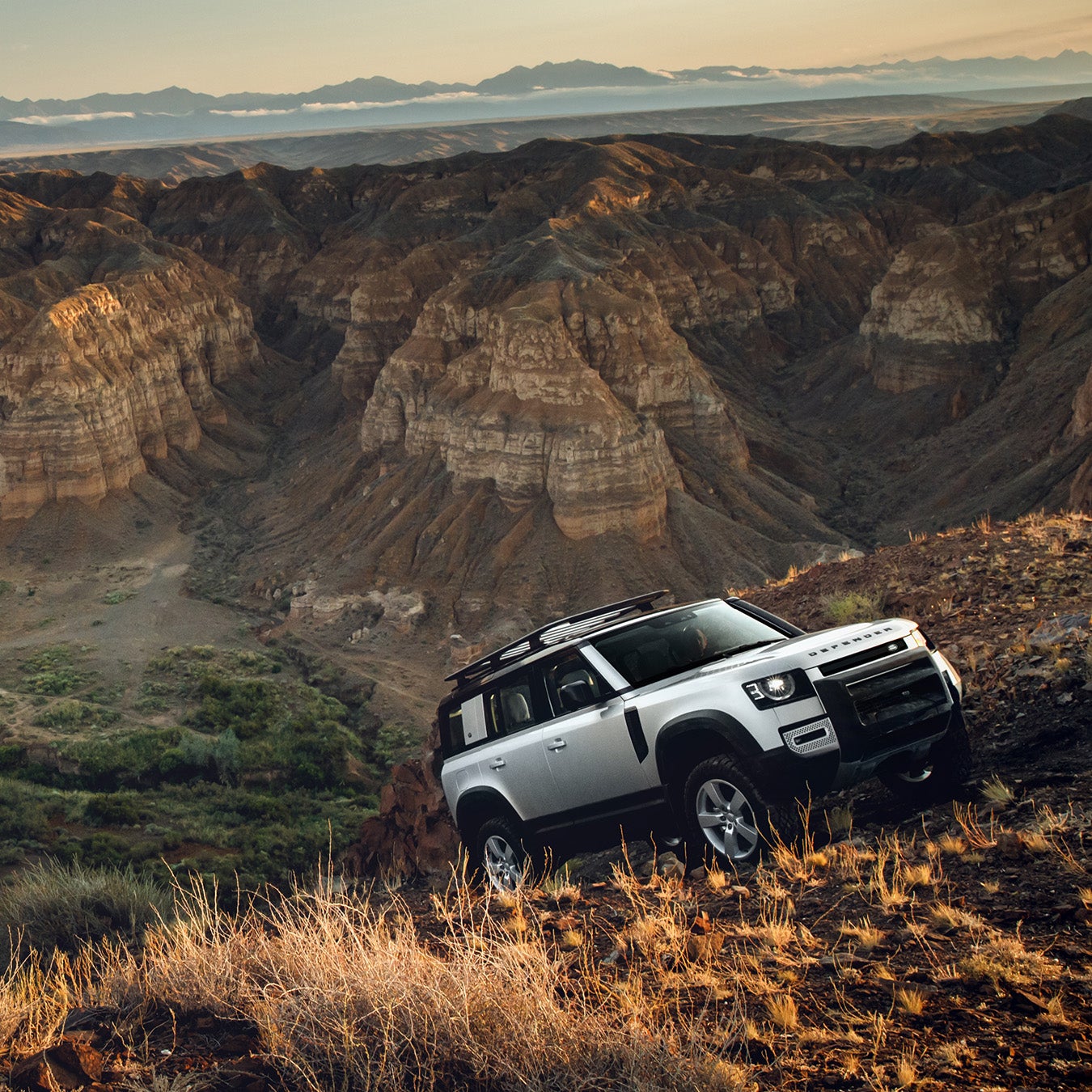The 2020 Land Rover Defender is a completely new vehicle that does not share a single component with its iconic ancestor. And, features like fully-independent air suspension and hybridized gasoline-electric powertrain mean this is now a truly modern vehicle. Will it be as capable off-road as the old one?
Along with a small handful of other journalists, I was given an advance preview of the new Defender at Land Rover’s design center in Gaydon, England, in early July. There, I was able to go hands-on with the vehicle months before anyone else outside the company would ever see it—and ask its engineers and designers tough questions about its true capability.
Those expecting a return to the ladder frame, live axle, fix-it-with-a-Swiss-Army-knife Defenders of yore need to come to terms with the fact that Land Rover has no intentions of bringing a nearly 40-year-old vehicle design back to production. The new Defender will, “transition from a specialist 4×4 to a luxury SUV,” says Nick Rodgers, the project’s chief engineer. “We can’t be held back by our heritage.”
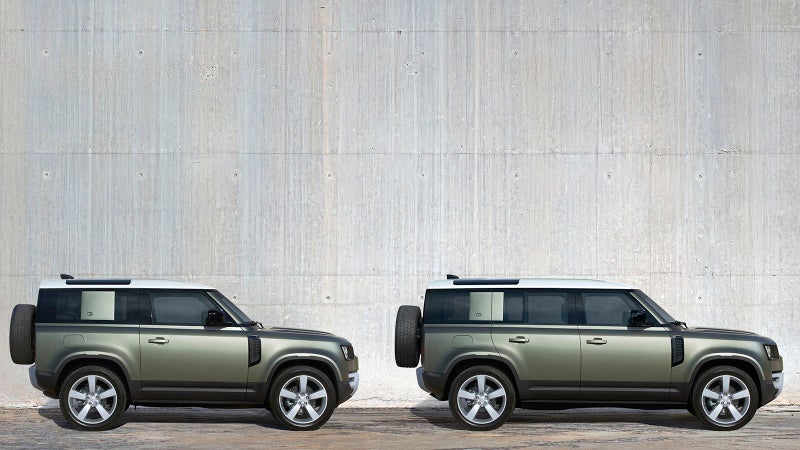
Design
This will be the most controversial SUV in recent memory. And frankly, the future of Land Rover’s brand hangs on its success. Without a rough-and-ready Defender, what separates Land Rover from Lexus?
The original Defender was born into a still-developing world. Back in the early ‘80s, many roads were still unpaved, global warming was still a blip on the radar, and crash test standards were…rudimentary. In contrast, this new Defender needs to be relevant to the modern world—and continue that relevancy for the next decade. Right now is an awkward time to be an SUV: we’re on the verge of all-passenger vehicles going fully electric, and true autonomous driving. Dirt roads are getting harder to find, and most of us now live in cities.
In silhouette, the new Defender looks strikingly similar to the old one. Both are boxy, with short overhangs at each end, and they both wield a rear-mounted spare tire. The new one also includes the old one’s signature alpine windows in the curve of the roof—a fantastic, functional nod to Land Rover’s heritage. But while there’s no doubt that the new Defender is an attractive machine, I also think it’s a bit of a compromised design that’s stuck somewhere between the past and the future.
This new Defender is full of features intended to recall the original’s agricultural heritage. Options like a bench front seat, rubber floors, and steel wheels seem purposeful, but with a starting price of $49,000 and an options list that will quickly take that price tag north of $80,000, this is a vehicle that sits firmly in the realm of the luxury SUV.

While those striking spartan options remain functional, the new Defender has one feature that won’t be optional and represents a questionable-at-best nod to the function of the original: diamond plate inserts on the hood. The only reason these existed on the old Defender was so you could stand on the fenders, but according to the current design team, these inserts on the new one can’t support weight, and are therefore only cosmetic. In other words, they’re fake.
The old Defender was available with either a 90 or 110 inch wheelbase, known as the Defender 90 and 110, respectively. The new Defender will also be available in 90 and 110 versions, just now with 101.9 and 119-inch measurements. Tantalizingly, it’s the 110 that will hit that $49,000 starting price when it goes on sale next spring. The 90 won’t reach our shores until fall, and leaves open the possibility of an even lower base price.
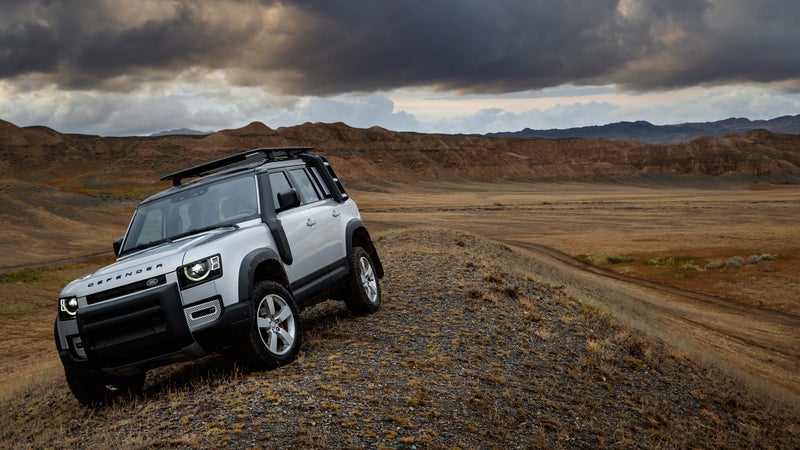
Two Available Engines
In the United States, the Defender will initially be available with two engine options: a 2.0-liter turbocharged four-cylinder, and a 3.0-liter inline-six fitted with a mild hybrid system.
Badged P300, the four-cylinder motor makes a very healthy 296 horsepower, and delivers a 0-60 miles per hour time of 7.7 seconds.
P400 models will start at $62,250, and assist the six-cylinder motor with both a turbocharger, and a belt-integrated starter motor that assists the engine with electric power, for a combined 395 horsepower and 406 pound-feet of torque. It’s good for a 0-60 time of just 5.8 seconds.
Both motors are paired with ZF’s excellent eight-speed automatic transmission, operated through a dash-mounted shifter.
While no one outside of Land Rover has driven the new Defender yet, we have tried the P400’s powertrain in the Range Rover Sport. It’s torquey on the road, and controllable off it, delivering levels of performance in both environments that will simply embarrass the old model.
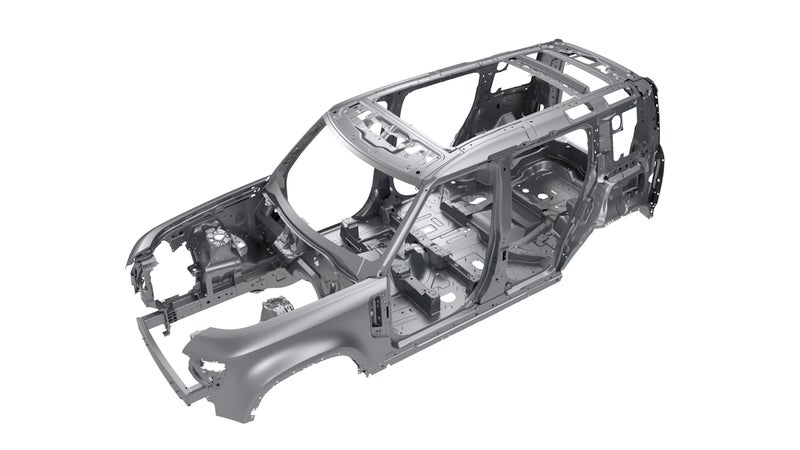
A Heavy Duty Platform
Land Rover is calling the new Defender’s chassis D7X. It’s based on the monocoque platform that underpins the current Discovery, Range Rover Sport, and Range Rover, but is upgraded to support more abusive off-road use. The use of this monocoque chassis may prove controversial to off-road enthusiasts, but Land Rover says testing has shown D7X to be three times stiffer than the strongest ladder chassis it’s ever tested. The platform has proven to be extremely robust in vehicles like the new Discovery, and is here upgraded with even more robust components like 5 millimeter larger ball joints in the lower control arms. I don’t know if you geek out on control arm ball joints like I do, but if you do, you’ll understand how much stronger and long-lasting that will make this platform.

The Accessories You Want
Technical performance is dorky, and difficult to understand. While the Defender is fitted with all manner of parts that will aid it’s capability off-road—the snorkel and locking rear differential, for instance—it’s parts like the integrated shower, factory roof rack, and purpose-built rooftop tent that we think buyers will appreciate most.
Out favorite option is the available shower-rinse kit. It offers just under two gallons of on-board water storage, along with a high-pressure nozzle. In short, it’s the perfect solution for cleaning up after a sweaty hike, or spraying off your muddy dog before loading them into your $80,000 SUV.
The roof rack also offers unprecedented functionality. The platform rack is aerodynamic, and built specifically for the vehicle by Land Rover, which has integrated it into the vehicle’s structure so it can handle 370 pounds of dynamic (read: while driving) capacity. That’s the most we’ve ever seen on a modern vehicle.
There’s also options like an integrated air compressor, for adjusting tire pressures on the trail, a ladder that runs down the side of the vehicle, a hidden winch mount, and more. This is, by far, the most comprehensive list of overland-style accessories available directly from a vehicle manufacturer. And that means you’ll be able to roll the cost of these components into your monthly payments, and have them supported by your factory warranty.
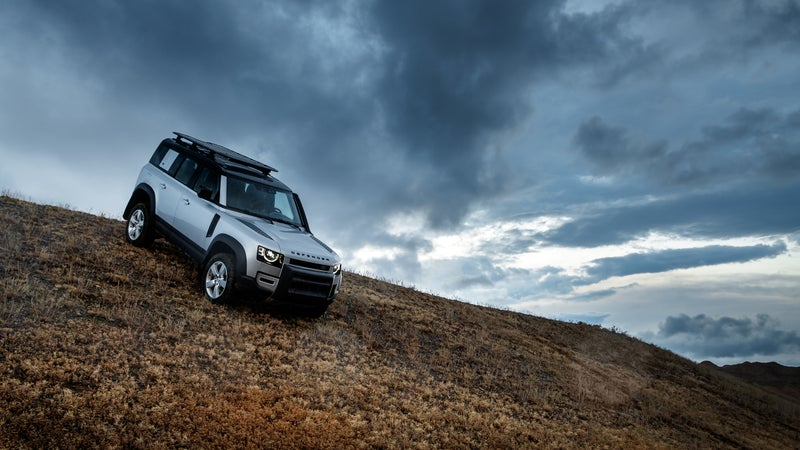
The Technical Stuff
While the Jeep Wrangler will still be the better choice for challenging terrain, this new Defender will debut as one of the most capable SUVs ever sold. Its fully-independent suspension architecture is industry-leading for durability and performance, offering wheel travel figures of 10.5 inches in the front, and 12.4 inches in the rear when equipped with air suspension. That same option also allows for five inches of ride height adjustability, at the push of a button.
Put that air suspension in off-road mode, and the Defender achieves a maximum approach angle of 38 degrees. While this is still far behind the Jeep Wrangler Rubicon’s 44 degree figure, the Defender 90 actually has the Jeep beat on breakover (28 versus 27.8 degrees), ground clearance (11.5 versus 10.9 inches), departure (40 versus 37 degrees), and wading depth (35.4 versus 30 inches).
Carrying on that comparison with the Wrangler, you’ll see that the Defender is capable of towing and hauling far more weight. Where the Jeep’s payload ranges from 1,090 to 1,361 pounds, the Defender is capable of carting around nearly 1,800 pounds of your stuff. And where the Jeep can only tow 3,500 pounds, the Defender is capable of towing a hugely impressive 8,200 pounds.
Thirty-two-inch tires will be standard, while wheel sizes range as large as 22 inches. Thankfully, there’s both an 18-inch steel wheel and all-terrain tire option. The taller tire sidewall made possible by the smaller wheels will be far less puncture-prone off-road, while delivering much improved ride quality everywhere.
Off-road enthusiasts will be keen to know that while P400 Defenders are fitted with 3.55 axle ratios, a factory 4.10 ratio is standard on the P300, so re-gearing for larger tires will be possible using factory parts. All models will use the same 2.93:1 low-range transfer case, and locking center and rear differentials are also standard.
Speaking with the engineering team, I asked about the ability to fit larger off-road tires. They said a 35-inch tire will certainly fit, but will require a one-inch suspension lift. A response that direct gave me the feeling that someone at Land Rover had already tried this.
One design element that is going to frustrate off-road modifications is the front bumper. It integrates cooling elements that Rob Atkin, the Defender’s technical director describes as “essential.” So, you won’t simply be able to remove that bumper and replace it with a common steel item. Instead, the aftermarket will need time to develop dedicated solutions that retain the cooling system’s functionality. But, there is at least a factory winch and mounting kit available, and those will work in concert with the vehicle’s cooling needs.
Land Rover also intends to offer a self-healing wrap for the Defender, giving buyers the option to change the vehicle’s color or graphics, while protecting the stock paintwork from scratches.
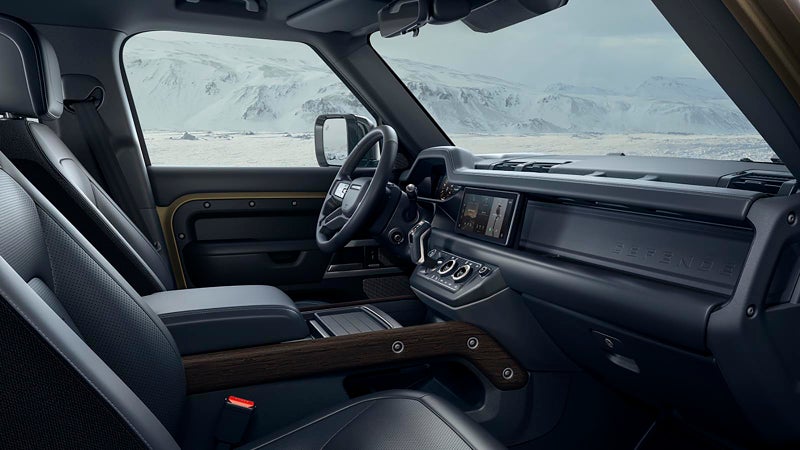
Advanced Technology
The Defender will be the first Land Rover equipped with the new, seventh-generation Terrain Response suite of electronic off-road aids. These offer drivers a vast range of configurable traction control, suspension, brake, and throttle settings that will allow novices an unprecedented level of assistance, and experts new levels of control.
These settings are controlled through the dash-mounted touchscreen, which also incorporates a display from a forward-facing camera that gives drivers a clear view of sections of the trail the may be obscured by the hood.
Terrain Response 7 incorporates, for the first time, a dedicated mode for water wading, which will automatically lock the differentials, max out the suspension height, soften throttle response, recirculate cabin air, and allow drivers to observe water depths using the front-facing camera. As the vehicle leaves the water, Terrain Response will automatically drag the brakes for a few seconds, cleaning and drying the discs.
The capability described above is supported by a next-generation anti-lock brake system that responds twice as fast as what was previously possible. The Defender can now lock a wheel in just 150 milliseconds, compared to the 300 milliseconds it takes vehicle like the Range Rover to do the same. Because Terrain Response prevents wheelspin using the ABS sensors and brakes, this will make the Defender’s entire suite of driver aids that much more capable. You can also expect the smoother application of features like hill descent control.
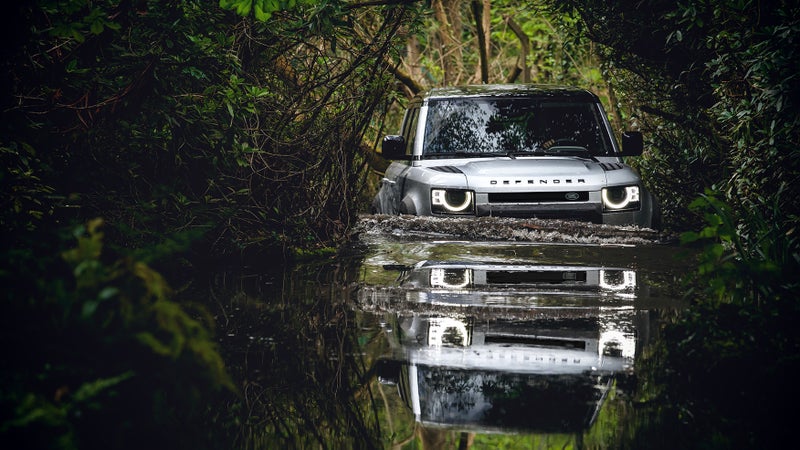
Should You Buy It?
We’ll reserve that judgement until we drive a production version of the new Defender later this year. Until then, I can simply say that the Defender is exceeding my expectations. Fake diamond plate aside, it’s shockingly good-looking in-person. And, just like the old one, it looks like it’s on an adventure even if it’s parked in your driveway.
All signs point to this new Defender being even more capable than the old one. It’s been tested everywhere from the wilds of Africa to Moab, Utah’s slick rock trails to the boiling-hot deserts of the Arabian peninsula. But, unlike the old one, this version has also been tested on all 154 turns of Germany’s famous Nurburgring race track. And that means this new one should be good at one thing the original never could quite handle: paved roads.


